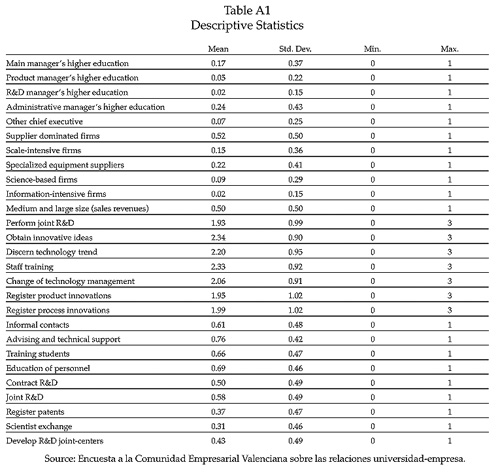Espacios. Vol. 24 (2) 2003
Industry-university interactions in Valencia, a peripheral european region
Interacciones Universidad-Industria en Valencia, una región periférica europea
Adela García-Aracil, Ignacio Fernández de Lucio, Antonio Gutiérrez Gracia y Elena de Castro Martínez
References
- Ali, A. (1994): “Pioneering versus incremental innovation: review and research propositions”, Journal of Product Innovation Management, 11, 46-61.
- Anselin, L., Varga, A., Acs, Z. (1997): “Local geographic spillovers between university research and high technology innovations”, Journal of Urban Economics, 42, 422-448.
- Bania, N., Calkins, L., Dalenberg, R. (1992): “The effects of regional science and technology policy on the geographic distribution of industrial R&D laboratories”, Journal of Regional Science, 32, 209-228.
- Bower, D.J. (1993): “Successful joint ventures in science parks”, Long Range Planning, 26(6), 114-120.
- Bozeman, B. (2000): “Technology transfer and public policy: a review of research and theory”, Research Policy, 29, 627-655.
- Burns, T., Stalker, G.M. (1961): The Management of Innovation, Tavistock, London.
- Cohen, W., Florida, R., Randazzese, L., Walsh, J. (1998): “Industry and the academy: uneasy partners in the cause of technological advance”, in Noll, R. (ed.), Challenges to Research Universities, The Brookings Institute Washington, DC, 171-200.
- Cohen, W., Levinthal, D. (1990): “Absorptive capacity: a new perspective on learning and innovation”, Administrative Science Quarterly, 35, 128-152.
- Frye, J. (1993): “University-industry cooperative research yields dividends”, International Journal of Technology Management, 8, 577-586.
- García-Aracil, A., Fernández, I., Gutiérrez, A. (2003): “Análisis de las actividades de investigación y desarrollo y de cooperación entre las comunidades académica y empresarial de la Comunidad Valencia”, Revista d’Estudis Autonòmics, Valencia.
- Geisler, E. (1995): “Industry-university technology cooperation: a theory of inter-organizational relationships, technology analysis”, Technology Analysis and Strategic Management, 7, 217-229.
- Green, W.H. (1997): Econometric Analysis, third edition, Prentice-Hall, New Jersey.
- Hamel, G., Prahalad, C.K (1994): Competing for the Future, Harvard Business School Press, Boston.
- Heckman, J.J. (1979): “Sample selection bias as a specification error”, Econometrica, 47, 153-161.
- Hicks, D. (2000): “Using innovation indicators for assessing the efficiency of industry-science relationships”, in Proceedings of the presentation of the paper at the joint German-OECD conference, Berlin.
- INE (2002): Estadística sobre las actividades en investigación científica y desarrollo tecnológico (I+D), Madrid.
- Jaffe, A., Trajtenberg, M., Henderson, R. (1993): “Geographic localization of knowledge spillovers as evidence by patent citations”, Quaterly Journal of Economics, 108, 577-598.
- Mora, E.M. (1999): “La cooperación universidad-empresa: un análisis de las dimensiones y tipología de los acuerdos de colaboración”, Revista de Ciencias Sociales y Jurídicas, Studia Carande, 2(4), 267-286.
- National Science Board (2000): Science and Engineering Indicators, National Science Foundation, US Government Printing Office, Washington, DC.
- Nelson, R., Winter, S. (1982): An Evolutionary Theory of Economic Change, Harvard University Press, Cambridge, M.A.
- OECD (2000): Analytical Report on High Tech Spin-offs, DSTI/STP/TIP, Paris.
- Okubo, Y., Sjoberg, C. (2000): “The changing pattern of industrial scientific research collaboration in Sweden”, Research Policy, 29(1), 81-98.
- Oliver, A.L., Liebeskind, J.P. (1998): “Three levels of networking for sourcing intellectual capital in biotechnology: implication for studying interorganizational networks, international studies of management”, International Studies of Management and Organization, 27(4), 76-103.
- Pavitt, K. (1984): “Sectoral patterns of technical change: towards a taxonomy and a theory”, Research Policy, 13(6), 343-373.
- Pisano, G. (1990): “The R&D boundaries of the firm: an empirical analysis”, Administrative Science Quartely, 35, 153-176.
- Prahalad, C.K. (1998): “Managing discontinuities: the emerging challenges”, Research Technology Management, 14-22.
- Rea, D., Brooks, H., Burger, R., LaScala, R. (1997): “The semiconductor industry-model for industry university government cooperation”, Research Technology Management, 46-54.
- Reams, R. (1986): University-Industry Research Partnerships, Quorum Books, Westport, Conn.
- Rosner, M (1968): “Economic determinants of organizational innovation”, Administrative Science Quarterly, 12, 614-625.
- Saviotti, P. (1998): “On the dynamics of appropriability of tacit and codified knowledge”, Research Policy, 26, 834-5-856.
- Schartinger, D., Rammer, C., Fischer, M.M, Fröhlich, J. (2002): “Knowledge interactions between university and industry in Austria: sectoral patterns and determinants”, Research Policy, 31, 303-328.
- Steele, L. (1989): Managing Technology, McGraw-Hill, New York.
- Teece, D.J., Pisano, G., Shuen, A. (1997): “Dynamic capabilities and strategic management”, Strategic Management Journal, 18, 509-533.
- Van Rossum, W., Cabo, P. (1995): “The contribution of research institutes in EUREKA projects”, International Journal of Technology Management, 10, 853-866.
- Varga, A. (2000): “Regional economic effects of university research: a survey”, Working Paper, Department for Economic Geography and Geoinformatics, University of Economics and Business Administration, Vienna.
- Varga, A. (1998): University Research and Regional Innovation, a Spatial Econometric Analysis of Academic Technology Transfers, Kluwer Academic Publishers, London.
- Zmud, R.W. (1982): “Diffusion of modern software practices: influence of centralization and formalization”, Management Science, 28, 1421-1431.
Appendix A
[anterior] [Volver al inicio]
